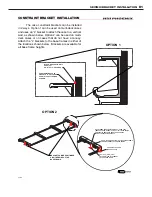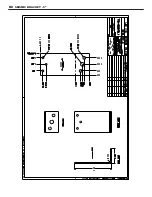
CASE CLEANING
A periodic cleaning schedule should be established to
maintain proper sanitation, insure maximum operating ef-
ficiency, and avoid the corrosive action of food fluids on
metal parts that are left on for long periods of time. We
recommend cleaning once a week. Further suggestions
for case cleaning include the following:
•
To avoid shock hazard, be sure all electrical power is
turned off before cleaning. In some installations, more
than one disconnect switch may have to be turned off
to completely de-energize the case.
•
All surfaces pitch downward to a deep-drawn drain
trough, funneling liquids to the front of the case where
the waste outlet is located for easy access. Check the
waste outlet to insure it is not clogged before starting
the cleaning process and avoid introducing water fast-
er than the case drain can carry it away.
•
To clean the LED luminaires, shut off the lights in the
case, then wipe the luminaires down with a soft, damp
cloth. Avoid using harsh or abrasive cleaners as they
may damage the lights. Be certain that the luminaires
are completely dry before re-energizing.
•
If any potentially harmful cleaners are used, be cer-
tain to provide a temporary separator (e.g., cardboard,
plastic wrap, etc.) between those cases that are being
cleaned and those that may still contain product.
•
Avoid spraying any cleaning liquids directly on the
electrical connections.
•
Allow cases to be turned off long enough to clean any
frost or ice from coil and pans.
•
Remove kickplate and clean underneath the case with
a broom and a long-handled mop. Use warm water
and a disinfecting cleaning solution when cleaning un-
derneath the cases.
Fig. 16 Single-piece fan plenum and coil cover
SINGLE PIECE FAN
PLENUM SWINGS
UP FOR EASY
CLEANING
FAN
PLENUM
COIL
FANS & CASE MAINTENANCE
FANS
The evaporator fans are equipped with 16-watt fan motors.
Motors have a counter-clockwise rotation when viewed
from the shaft end.
The fan blades are 8” in diameter and the fan blade pitch
is set during the assembly process. It is important that the
blade pitch be maintained as specified. Do not attempt a
field modification by altering the blades.
Fan motors may be changed with an easy two-step pro-
cess (Fig. 15) without lifting up the plenum, thereby avoid-
ing the necessity to unload the entire product display to
make a change:
1. Unplug the fan motor, easily accessible outside the
plenum. Push cord back through plenum opening.
2. Remove fasteners, then lift out the entire fan basket.
Reverse procedure when re-installing fan basket.
2
Fig. 15 Fan basket
1
CAUTION!
Exercise extreme caution when working in
a case with the coil cover removed. The
coil contains many sharp edges that can
cause severe cuts to the hands and arms.
ATTENTION!
Power cord must be pushed back through
the plenum opening before removing the
fan basket. Failure to do so may result in
damage to the power cord.
DANGER!
SHOCK HAZARD
Always disconnect power to case when
servicing or cleaning. Failure to do so
may result in serious injury or death.
9
Summary of Contents for 3NDML-NRG
Page 16: ...BLUE WHITE BLACK 3NDML WIRING DIAGRAM B2 ...
Page 19: ...SEISMIC BRACKET 5 D2 ...
Page 20: ...SEISMIC BRACKET 7 D3 ...
Page 21: ...SEISMIC BRACKET 11 D4 ...
Page 22: ...SEISMIC BRACKET 15 D5 ...


























